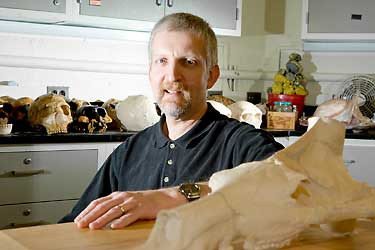Bill Sanders is a paleontologist, world ambassador, anatomist, experimenter and teacher, and he has spent nearly 20 years at U-M bringing the past to life.

Sanders, the chief vertebrate preparator for the Museum of Paleontology, has spent the majority of his career studying, helping to recover, and restoring ancient fossils, including a 47 million-year-old walking whale and ancient sea cows.
“Fossils are the data of paleontologists. The fossil-removal process isn’t like Jurassic Park—the difficulty is that the rock is much harder than the bone. We have to find a way to harden the bone without damaging it,” Sanders says. In searching for techniques to remove the bones from the rock it is embedded in, he says, “We are really making it up as we go along. We get ideas from the toy-making, tool-and-die, car making, dental, art supply, and model-making industries.”
His tasks at the museum, which include purchasing materials and planning work for students in the labs, involve a high level of chemical and anatomical training.
“It is a lot more fun than a straight academic field. You use your imagination and think outside the box,” he says. “There is an artistic as well as a technical aspect. If you like using your hands and imagination, it’s the best job in the world.”
When he isn’t in the lab working with students, curators or faculty, Sanders travels the world on excavations in ancient and remote areas such as Baluchistan, Congo, Turkey and the Rift Valley of Tanzania.
Sanders took his most recent trip last summer to Cape Town, South Africa; Nairobi, Kenya; and London, where he worked with colleagues at the South African Museum, Kenya National Museum and the Natural History Museum. He usually takes one to two trips per year.
While traveling thousands of miles to excavate ancient remains of animals, his adventures abroad have taught him lessons in life.
“One time in Pakistan, a tiny shepherd boy appeared when I was excavating a sea cow. I looked up at him, and he ran off for a bit. He returned with an ancient-looking thermos filled with tea. I gave him some candy in exchange, and we had a moment of friendship. Now I have a friend for life,” he chuckles. “But I never saw him again.
“But really, the more different people seem, the closer they are. The world seems to be such a dangerous place—but underneath, people are generally pretty nice. It’s just too bad we can’t translate that to a larger picture.”
His interest in the wonders of the outdoors as a small boy burgeoned into a passion for understanding the ecosystem on a macro-level. “I grew up in a house my parents rented on a farm,” Sanders recalls. “I remember there were creeks, turtles, frogs and snakes. I had no fear of the outdoors.”
While pursuing his doctorate in paleontology at New York University, Sanders also studied related fields such as geology, chemistry and anatomy. In addition, he worked at the American Museum of Natural History in New York City.
“I really like the tactile aspect of the field. I love admiring the three-dimensional beauty of skulls and bones,” Sanders says. “There is nothing like seeing a skull emerge from a piece of rock. It’s like you are in a time machine, watching the fossils reappearing slowly from millions of years ago.”

